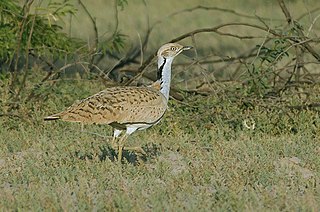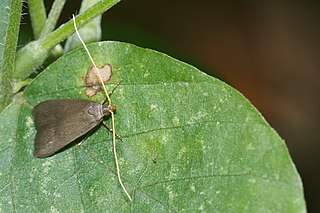Related Research Articles

The houbara bustard, also known as African houbara, is a large bustard native to North Africa and southwestern Asia, where it lives in arid habitats. The global population is listed as Vulnerable on the IUCN Red List since 2014. The European population is restricted to the Canary Islands and has been assessed as Near Threatened in 2015.

The yellow-billed duck is a 51–58 cm long dabbling duck which is an abundant resident breeder in southern and eastern Africa.

Tecomella undulata is a tree species, locally known as rohida found in Thar Desert regions of India and Pakistan. It is a medium-sized tree that produces quality timber and is the main source of timber amongst the indigenous tree species of desert regions of Shekhawati and Marwar in Rajasthan. The trade name of the tree species is desert teak or Marwar teak.

MacQueen's bustard is a large bird in the bustard family. It is native to the desert and steppe regions of Asia, east from the Sinai Peninsula extending across Kazakhstan east to Mongolia. In the 19th century, vagrants were found as far west of their range as Great Britain. Populations have decreased by 20 to 50% between 1984 and 2004 mainly due to hunting and changes in land-use. MacQueen's bustard is a partial latitudinal migrant while the houbara bustard is more sedentary. Both species are the only members of the genus Chlamydotis. MacQueen's bustard used to be regarded as a subspecies of the houbara bustard and known as the "Asian houbara".

Silene undulata is a plant native to the Eastern Cape of South Africa.

The Lecithocerinae are a subfamily of small moths in the family Lecithoceridae. They are found worldwide, but most species occur in South Asia. The subfamily is characterized by the male genitalia with a bridge-like structure connecting the tegumen and the valva, and the uncus almost always is vestigal with two lobes at the dorsal base, only exceptionally united into a broad plate, but never as a thorn or spine.

The undulate ray is a species of ray and cartilaginous fish found in the Mediterranean and East Atlantic from southern Ireland and England to the Gulf of Guinea. It is found in areas with mud or sand, and may occur as deep as 200 m (660 ft), though it prefers shallower depths. It is considered endangered due to overfishing.

Nosphistica is a genus of moth in the family Lecithoceridae.

The Albany thickets is an ecoregion of dense woodland in southern South Africa, which is concentrated around the Albany region of the Eastern Cape.

Hakea undulata, commonly known as wavy-leaved hakea, is a shrub that is native to the south-west of Western Australia. It has stiff wavy leaves and fragrant cream-white flowers from mid-winter to October.

Rheumaptera undulata, the scallop shell, is a moth of the family Geometridae. It was first described by Carl Linnaeus in his 1758 10th edition of Systema Naturae. It is found in most of the Palearctic realm and North America.

Nosphistica bisinuata is a moth in the family Lecithoceridae which is endemic to Taiwan.
Nosphistica parameocola is a moth in the family Lecithoceridae. It is found in Taiwan and southern China (Hainan).
Nosphistica fuscolepis is a moth in the family Lecithoceridae which is endemic to Taiwan.
Nosphistica tarokoensis is a moth in the family Lecithoceridae which is endemic to Taiwan.

Melaleuca undulata, commonly known as hidden honey-myrtle is a shrub in the myrtle family Myrtaceae and is endemic to the south of Western Australia. It is a spreading, moderately dense, perennial, woody shrub with creamy-white flowers in small clusters.
Nosphistica acriella is a moth in the family Lecithoceridae. It was described by Kyu-Tek Park in 2002. It is known from Thailand.
Nosphistica metalychna is a moth in the family Lecithoceridae. It was described by Edward Meyrick in 1935. It is known from southern China.
Nosphistica orientana is a moth in the family Lecithoceridae. It was described by Kyu-Tek Park in 2005. It is found in Guangdong, China.
Nosphistica owadai is a moth in the family Lecithoceridae. It was described by Kyu-Tek Park in 2005. It is found in Vietnam.
References
- ↑ Savela, Markku (January 18, 2015). "Nosphistica undulata Park, 2002". Lepidoptera and Some Other Life Forms. Retrieved November 5, 2019.
| This article relating to the subfamily Lecithocerinae is a stub. You can help Wikipedia by expanding it. |